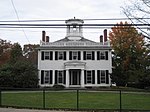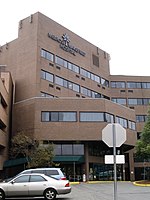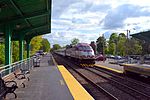Melrose Public Library
Buildings and structures in Melrose, MassachusettsCarnegie libraries in MassachusettsLibraries in Middlesex County, MassachusettsLibraries on the National Register of Historic Places in MassachusettsLibrary buildings completed in 1904 ... and 3 more
Middlesex County, Massachusetts Registered Historic Place stubsNational Register of Historic Places in Middlesex County, MassachusettsPublic libraries in Massachusetts

The Melrose Public Library is a historic library at 69 W. Emerson Street in Melrose, Massachusetts. The original T-shaped building was built in 1904, and is a two-story Colonial Revival structure faced in brick with limestone trim. It was built with funds contributed by philanthropist Andrew Carnegie to a design by Lynn architect Penn Varney, and features stained glass windows by Wilbur H. Burnham. A modern single story addition was added in 1963 to the rear and left side of the building.The building was listed on the National Register of Historic Places in 1988.The Library is a member of the North of Boston Library Exchange (NOBLE) consortium.
Excerpt from the Wikipedia article Melrose Public Library (License: CC BY-SA 3.0, Authors, Images).Melrose Public Library
West Emerson Street,
Geographical coordinates (GPS) Address Nearby Places Show on map
Geographical coordinates (GPS)
| Latitude | Longitude |
|---|---|
| N 42.459166666667 ° | E -71.067222222222 ° |
Address
West Emerson Street 93
02176
Massachusetts, United States
Open on Google Maps









